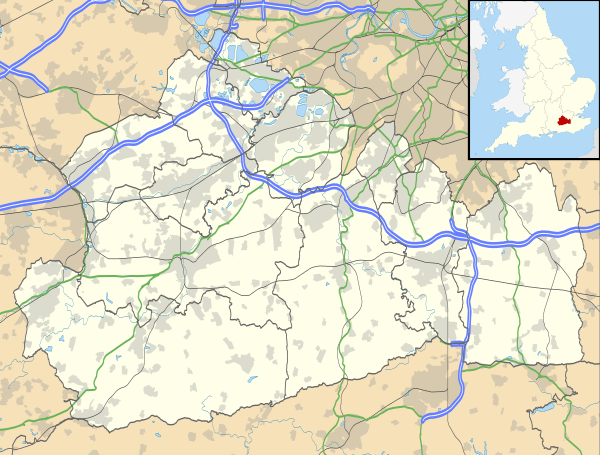Ockley
| Ockley | |
| Ockley Green |
|
 Ockley |
|
| Area | 13.75 km2 (5.31 sq mi) |
|---|---|
| Population | 871 (Civil Parish 2011)[1] |
| – density | 63/km2 (160/sq mi) |
| OS grid reference | TQ1540 |
| Civil parish | Ockley |
| District | Mole Valley |
| Shire county | Surrey |
| Region | South East |
| Country | England |
| Sovereign state | United Kingdom |
| Post town | Dorking |
| Postcode district | RH5 |
| Dialling code | 01306 |
| Police | Surrey |
| Fire | Surrey |
| Ambulance | South East Coast |
| EU Parliament | South East England |
| UK Parliament | Mole Valley |
Coordinates: 51°08′53″N 0°21′47″W / 51.148°N 0.363°W
Ockley is a rural village in Surrey. It is lies astride the A29, the modern road using the alignment of Stane Street (Chichester). The A29 diverges from the A24 from London about 2.5 miles northeast and takes the alignment of Stane Street a mile north of the village. It has a medieval parish church, see list of places of worship in Mole Valley.
History
Finds of small artifacts dating to Roman Britain associated with the Roman road stretching from Chichester to London have been made since at least the 19th century.[2]
Ockley's name fits the uncertain site of where battle took place described in the entry for the year 851 of the Anglo-Saxon Chronicle. According to the chronicler, king Æthelwulf and his son Æthelbald, together with the West-Saxon army, fought against an invading Danish army of 350 ships that had plundered London and Canterbury previously, and had also put king Beorhtwulf of Mercia to flight. The chronicler refers to the battlefield as Aclea, Oak Lea, and the Danish army was defeated suffering “the greatest slaughter… we have heard tell of up to this present day”.
Ockley appears in Domesday Book of 1086 as Hoclei. It was held by Radulf (Ralph) from Richard Fitz Gilbert. Its domesday assets were: 1 hide. It had 5 ploughs, woodland worth 20 hogs. It rendered £3 10s 0d to its overlords per year.[3]
Nicholas Culpeper, a leading Stuart period herbalist, was born here on 18 October 1616.
In 1911 the parish was "agricultural, except for a little brick and tile making".[2]
Amenities
School
The village has one small primary school, Scott-Broadwood School which is one of two sites for the school with the other being in Capel.
Public houses
As of September 2016 the village has two pubs; The Inn On The Green and the Cricketer's Arms both of which are on the main road through the village. Both pubs sell hot food with the Inn On The Green also serving as the only B&B in the village.
Shops
Since the closure of the village shop adjacent to the green the village only has the one shop which forms part of the filling station towards the southern end of the village. Just outside the village on Coles Lane is the Village Greens farm shop which sells fresh produce.
Sports
Informal football is generally played on Ockley Green which has football posts in place.
Ockley has Gatton Manor Golf Course on the outskirts of the village, within the parish bounds.[4]
The village has featured in longer routes of the London-Surrey Cycle Classic.
Geography
Between Dorking and Horsham, close to the Sussex/Surrey border, Ockley stretches to the escarpment of Leith Hill, the second highest point in South East England, after Walbury Hill in the far south-west of Berkshire. The northern border is marked by the Greensand Ridge. Close to this small beds of Sussex marble, which is remnants of a former limestone area of the Weald, are found.[2]
 |
Holmbury St Mary | Coldharbour, Capel | South Holmwood |  |
| Ewhurst Green, Ewhurst | |
Capel | ||
| ||||
| | ||||
| Walliswood and Okewood or Oakwood Hill, Ewhurst | Warnham | Kingsfold |
Transport
Roads
The A29 is the main road through the village with Horsham to the south and Dorking to the north. Local minor roads provide relatively straight access from just north of the village's developed area to Ewhurst and Cranleigh to the west and Capel to the east.
Rail
The village is served by Ockley railway station which is 2 miles (3.2 km) to the east, due to a Victorian aristocrat having imposed his manor's name on a station closer to Capel, Surrey.
Demography and housing
| Output area | Detached | Semi-detached | Terraced | Flats and apartments | Caravans/temporary/mobile homes | shared between households[1] |
|---|---|---|---|---|---|---|
| (Civil Parish) | 147 | 132 | 44 | 18 | 11 | 0 |
The average level of accommodation in the region composed of detached houses was 28%, the average that was apartments was 22.6%.
| Output area | Population | Households | % Owned outright | % Owned with a loan | hectares[1] |
|---|---|---|---|---|---|
| (Civil Parish) | 871 | 352 | 34.7% | 26.7% | 1375 |
The proportion of households in the civil parish who owned their home outright compares to the regional average of 35.1%. The proportion who owned their home with a loan compares to the regional average of 32.5%. The remaining % is made up of rented dwellings (plus a negligible % of households living rent-free).
See also
References
- 1 2 3 Key Statistics; Quick Statistics: Population Density United Kingdom Census 2011 Office for National Statistics Retrieved 21 November 2013
- 1 2 3 H.E. Malden (editor) (1911). "Parishes: Ockley". A History of the County of Surrey: Volume 3. Institute of Historical Research. Retrieved 29 November 2013.
- ↑ Surrey Domesday Book
- ↑ Gatton Manor Retrieved 2013-11-29
External links
![]() Media related to Ockley at Wikimedia Commons
Media related to Ockley at Wikimedia Commons
